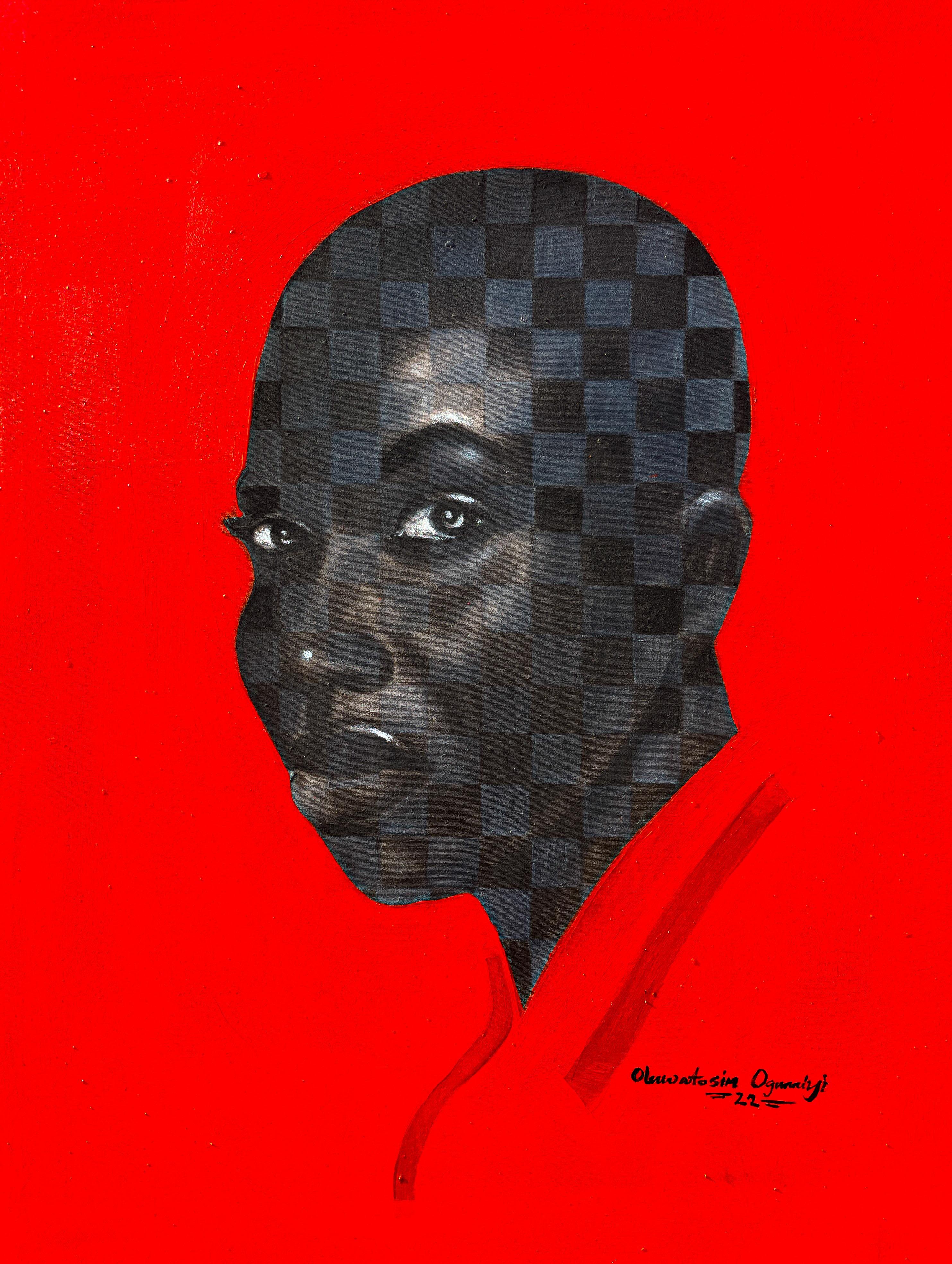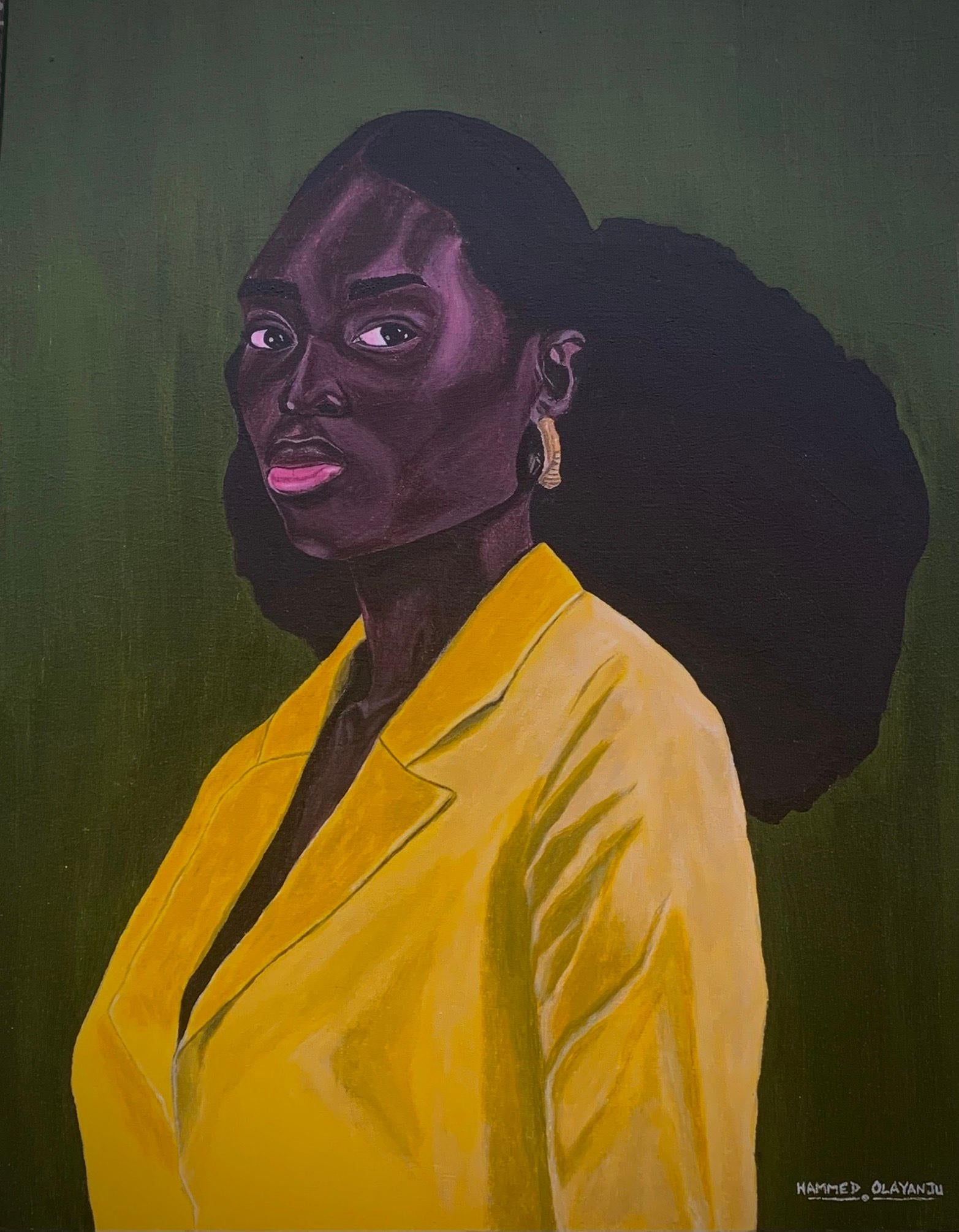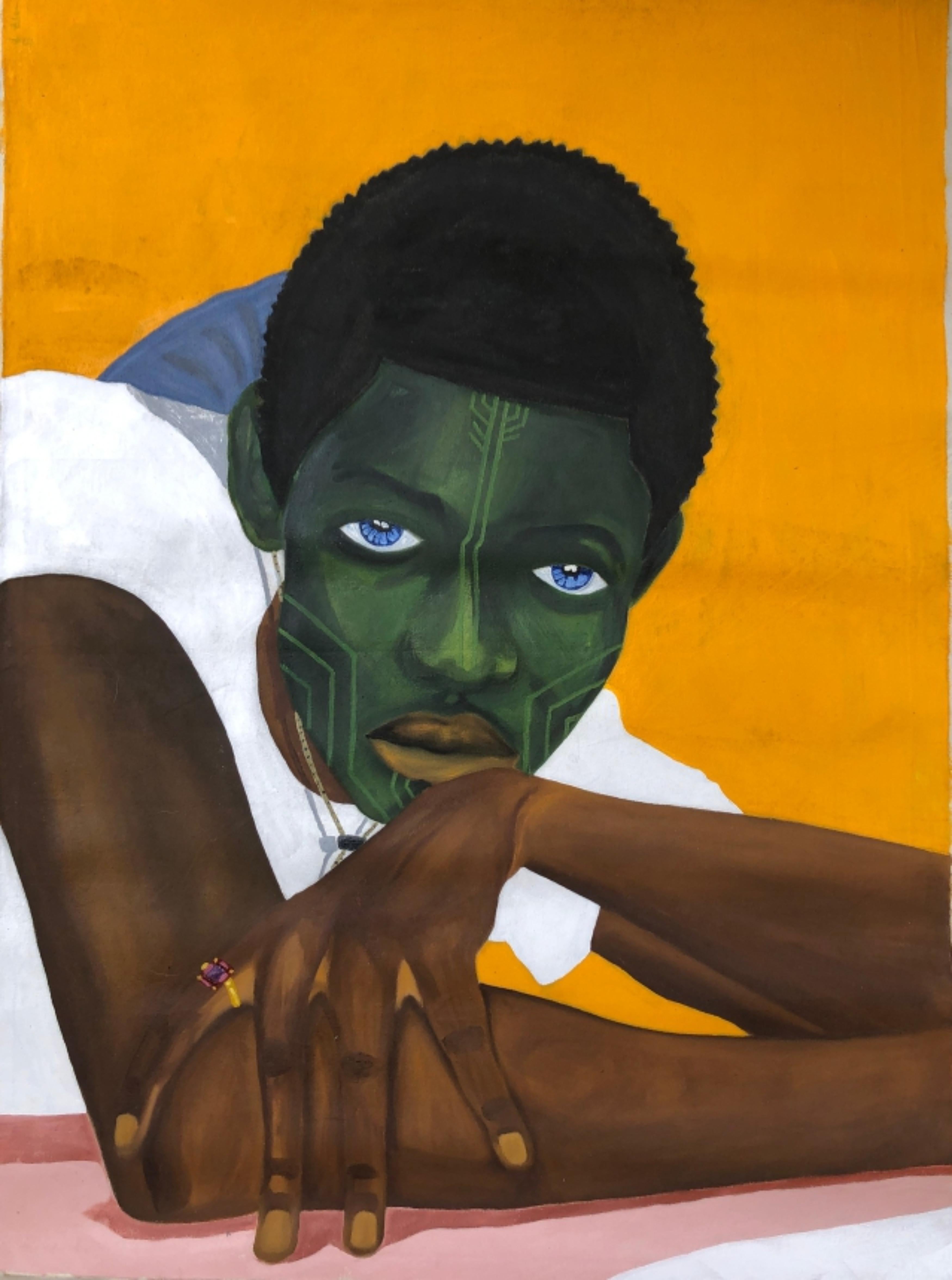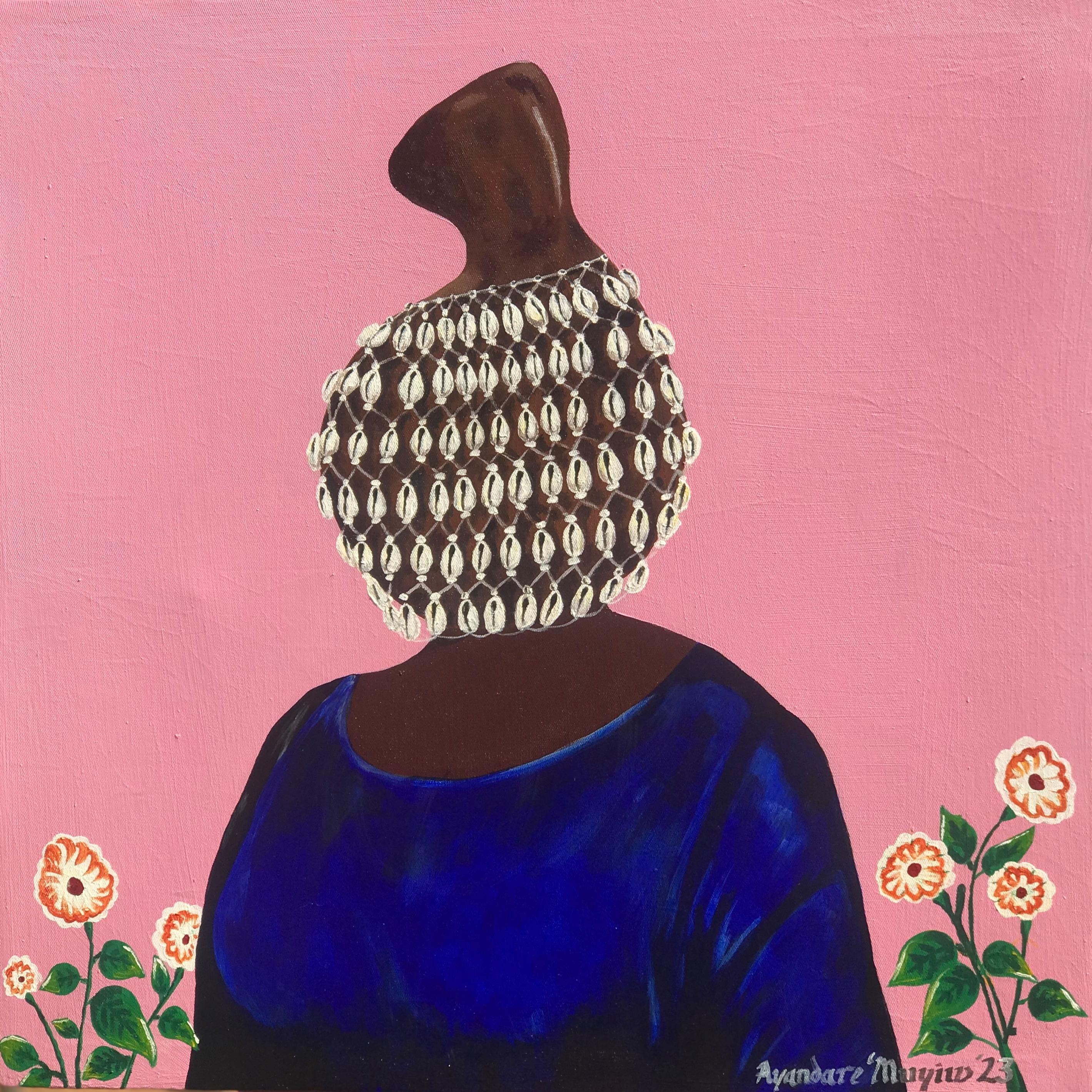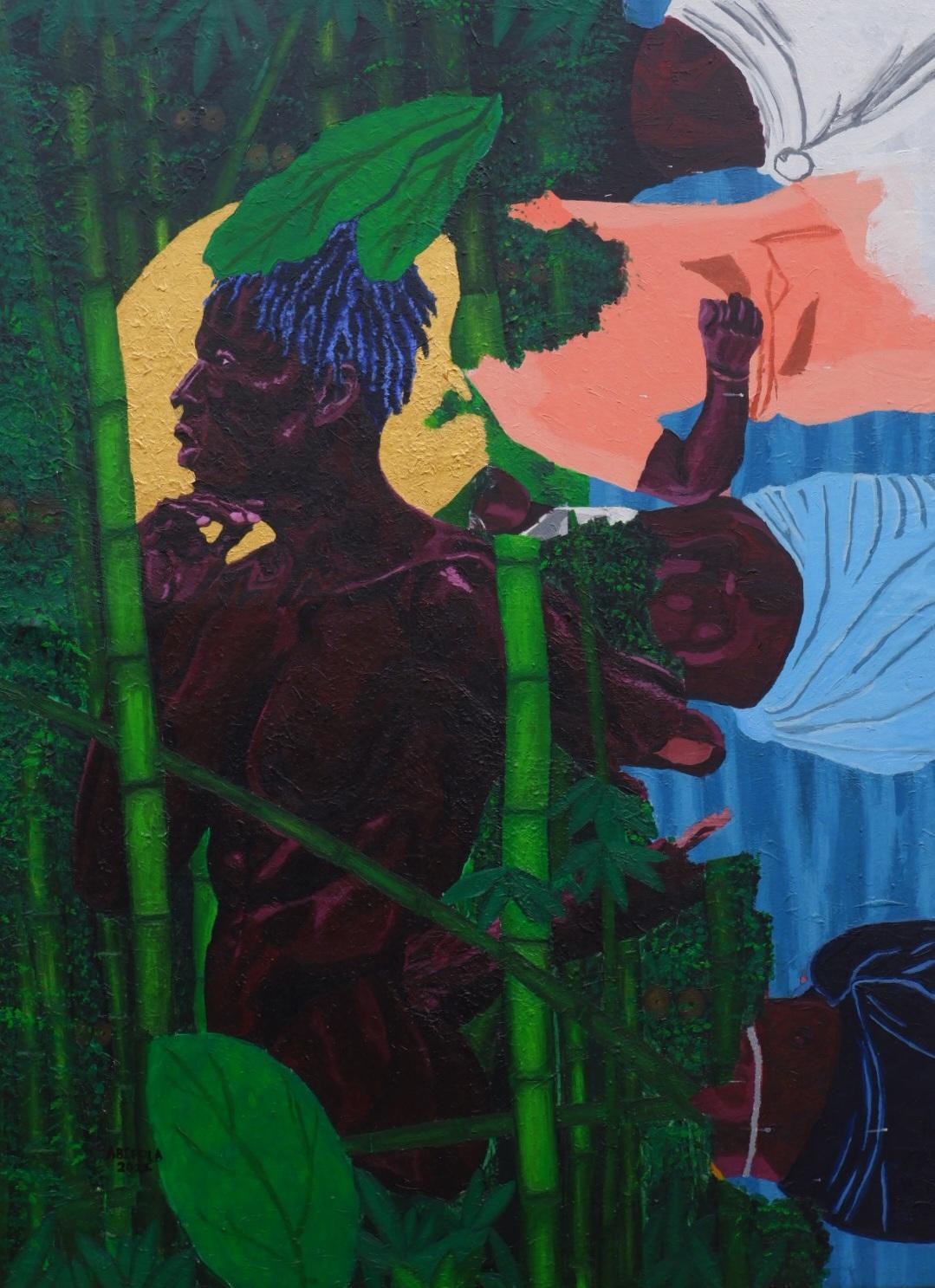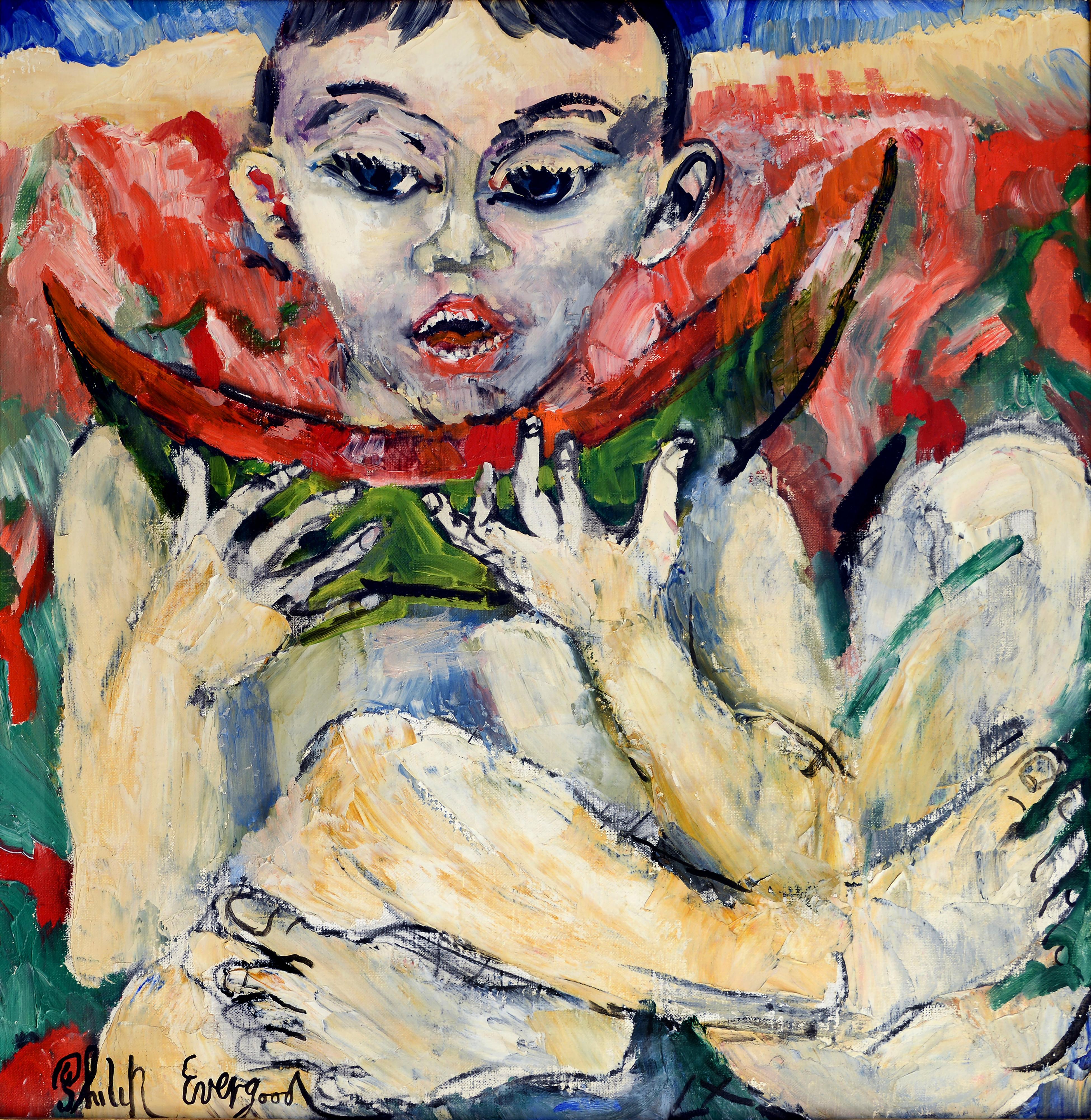Items Similar to Modernist Encaustic Painting Portrait Boston Expressionist
Want more images or videos?
Request additional images or videos from the seller
1 of 11
David AronsonModernist Encaustic Painting Portrait Boston Expressionist
About the Item
Bears old label verso from Raydon Gallery in New York city.
Aronson, David 1923-
David Aronson, son of a rabbi, was born in Lithuania in 1923 and immigrated to America at the age of five. He settled in Boston, Massachusetts where he studied at the school of the Museum of Fine Arts under Karl Zerbe, a German painter well known in the early 1900s. Aronson later taught at the school of the Museum of Fine Arts for fourteen years and founded the School of Fine Art at Boston University where he is today a professor emeritus. An internationally renowned sculptor & painter, Aronson has won acclaim for his interpretation of themes from the Hebrew Talmud and Kabala. His best known works include bronze castings, encaustic paintings, and pastels. His work is included in many important public and private collections, and has been shown in several museum retrospectives around the country. He is considered to be one of the most important 20th century American artists.
At twenty-two David Aronson had his first one-man show at New York's Niveau Gallery. The next year, six of his Christological paintings were included in the Fourteen Americans exhibition at Manhattan's Museum of Modern Art where Aronson’s work was included alongside abstract expressionists Arshile Gorky, Robert Motherwell and Isamu Noguchi. In the 1950s, Aronson turned more toward his Jewish heritage for the inspiration for his art. Folklore as well as Kabalistic and other transcendental writings influenced his work greatly. The Golem (a legendary figure, brought to life by the Maharal of Prague out of clay to protect the Jewish community during times of persecution) and the Dybbuk (an evil spirit that lodges itself in the soul of a living person until exorcised) frequently appear in his work.
In the sixties, Aronson turned to sculpture. His work during this period is best exemplified by a magnificent 8’ x 4’ bronze door which now stands at the entrance to Frank Lloyd Wright's Johnson Foundation Conference Center for the Arts in Racine, Wisconsin. In the seventies and eighties, Aronson continued his work in pastel drawings, paintings, and sculptures, often exploring religion and the frailties of man's nature. During this time, in addition to a traveling retrospective exhibition and many one-man shows in New York, Los Angeles, Chicago, and Boston at the Pucker-Safrai Gallery on Newbury Street, Aronson won many awards and became a member of the National Academy of Design in New York. Two years ago he retired from teaching to work full-time in his studio in Sudbury, Massachusetts.
included in the catalog
Contemporary Religious Imagery in American Art
Catalog for an exhibition held at the Ringling Museum of Art, March 1-31, 1974.
Artists represented: David Aronson, Leonard Baskin, Max Beckmann, Hyman Bloom, Fernando Botero, Paul Cadmus, Marvin Cherney, Arthur G. Dove, Philip Evergood, Adolph Gottlieb, Jonah Kinigstein, Rico Lebrun, Jack Levine, Louise Nevelson, Barnett Newman, Abraham Rattner, Ben Shahn, Mark Tobey, Max Weber, William Zorach and others.
Selected Awards
1990, Certificate of Merit, National Academy of Design
1976, Purchase Prize, National Academy of Design
1976, Joseph Isidore Gold Medal, National Academy of Design
1976, Purchase Prize in Drawing, Albrecht Art Museum
1975, Isaac N. Maynard Prize for Painting, National Academy of Design
1973, Samuel F. B. Morse Gold Medal, National Academy of Design
1967, Purchase Prize, National Academy of Fine Arts
1967, Adolph and Clara Obrig Prize, National Academy of Design
1963, Gold Medal, Art Directors Club of Philadelphia
1961, 62, 63, Purchase Prize, National Institute of Arts and Letters
1960, John Siimon Guggenheim Fellowship
1958, Grant in Art, National Institute of Arts and Letters
1954, First Prize, Tupperware Annual Art Fund Award
1954, Grand Prize, Third Annual Boston Arts Festival
1953, Second Prize, Second Annual Boston Arts Festival
1952, Grand Prize, First Annual Boston Arts Festival
1946, Traveling Fellowship, School of the Museum of Fine Arts
1946, Purchase Prize, Virginia Museum of Fine Arts
1944, First Popular Prize, Institute of Contemporary Art
1944, First Judge's Prize, Institute of Contemporary Art
Selected Public Collections
Art Institute of Chicago
Virginia Museum of Fine Arts
Bryn Mawr College
Brandeis University
Tupperware Museum, Orlando, Florida
DeCordova Museum
Museum of Modern Art Print Collection, New York
Atlanta University
Atlanta Art Association
University of Nebraska
Whitney Museum of Art
Corcoran Museum of Art
Smithsonian Institution
Portland Art Museum
Milwaukee Art Institute
Hunter Art Gallery
Pennsylvania Academy of Fine Arts
Hebrew Teacher's College, Brookline, Mass.
Container Corporation of America
Stone Foundation
The Johnson Foundation
Worcester Art Museum
University of New Hampshire
Chico State College Gallery
Munson-Williams-Proctor Institute
Witherspoon Art Gallery
Skirball Museum, Los Angeles
University of Judaism, Los Angeles
Danforth Museum of Art
Syracuse University
Boston University
Selected Solo Exhibitions
MB Modern, New York, 1997
Horwitch Newman Galleries, Scottsdale, Arizona, 1996
Louis Newman Galleries, Beverly Hills, 1977, 1982, 1984, 1986, 1989, 1992
Pucker-Safrai Gallery, Boston, 1976, 1978, 1984, 1986, 1990
Mickelson Gallery, Washington, D.C., 1985 (retrospective)
Southeastern Middlesex University, Dartmouth, Massachusetts, 1983 (retrospective)
Sadye Bronfman Art Center, Montreal, 1982
Towne Gallery, Lenox, Massachusetts, 1982
Rose Art Museum, Brandeis University, 1979 (retrospective)
American Museum of Jewish History, Philadelphia, 1979 (retrospective)
Jewish Museum and National Academy of Design, 1979 (retrospective)
Bernard Danenberg Galleries, New York, 1969, 1972
Verle Gallery, West Hartford, Connecticut, 1967
Kovler Gallery, Chicago, 1966
Hunter Gallery, Chatanooga, Tennessee, 1965
J. Thomas Gallery, Provincetown, 1964
Westhampton Gallery, New York, 1961
Rex Evans Gallery, Los Angeles, 1961
Nordness Gallery, New York, 1960, 1963, 1969
The Downtown Gallery, 1953
Boris Mirski Gallery, Boston, 1951, 1959, 1969
Museum of Modern Art, New York, 1946
Niveau Gallery, New York, 1945, 1956
- Creator:David Aronson (1923, Lithuanian)
- Dimensions:Height: 26.75 in (67.95 cm)Width: 16.75 in (42.55 cm)
- Medium:
- Movement & Style:
- Period:
- Condition:size includes frame. needs new mat and frame. minor wear.
- Gallery Location:Surfside, FL
- Reference Number:1stDibs: LU38213303992
About the Seller
4.9
Platinum Seller
These expertly vetted sellers are 1stDibs' most experienced sellers and are rated highest by our customers.
Established in 1995
1stDibs seller since 2014
1,549 sales on 1stDibs
Typical response time: 1 hour
- ShippingRetrieving quote...Ships From: Surfside, FL
- Return PolicyA return for this item may be initiated within 3 days of delivery.
More From This SellerView All
- Modernist Orchestra Musical Gouache Painting Boston ExpressionistBy David AronsonLocated in Surfside, FLVery vibrant, dynamic orchestra scene reminiscent of the work of Mopp (Max Oppenheim) David Aronson, (1923-2015) son of a rabbi, was born in Lithuania in 1923 and immigrated to America at the age of five. He settled in Boston, Massachusetts where he studied at the school of the Museum of Fine Arts under Karl Zerbe, a German painter well known in the early 1900s. Aronson later taught at the school of the Museum of Fine Arts for fourteen years and founded the School of Fine Art at Boston University where he is today a professor emeritus. An internationally renowned sculptor & painter, Aronson has won acclaim for his interpretation of themes from the Hebrew Talmud and Kabala. His best known works include bronze castings, encaustic paintings, and pastels. His work is included in many important public and private collections, and has been shown in several museum retrospectives around the country. He is considered to be one of the most important 20th century American artists. At twenty-two David Aronson had his first one-man show at New York's Niveau Gallery. The next year, six of his Christological paintings were included in the Fourteen Americans exhibition at Manhattan's Museum of Modern Art where Aronson’s work was included alongside abstract expressionists Arshile Gorky, Robert Motherwell and Isamu Noguchi. In the 1950s, Aronson turned more toward his Jewish heritage for the inspiration for his art. Folklore as well as Kabalistic and other transcendental writings influenced his work greatly. The Golem (a legendary figure, brought to life by the Maharal of Prague out of clay to protect the Jewish community during times of persecution) and the Dybbuk (an evil spirit that lodges itself in the soul of a living person until exorcised) frequently appear in his work. In the sixties, Aronson turned to sculpture. His work during this period is best exemplified by a magnificent 8’ x 4’ bronze door which now stands at the entrance to Frank Lloyd Wright's Johnson Foundation Conference Center for the Arts in Racine, Wisconsin. In the seventies and eighties, Aronson continued his work in pastel drawings, paintings, and sculptures, often exploring religion and the frailties of man's nature. During this time, in addition to a traveling retrospective exhibition and many one-man shows in New York, Los Angeles, Chicago, and Boston at the Pucker-Safrai Gallery on Newbury Street, Aronson won many awards and became a member of the National Academy of Design in New York. Two years ago he retired from teaching to work full-time in his studio in Sudbury, Massachusetts. included in the catalog Contemporary Religious Imagery in American Art Catalog for an exhibition held at the Ringling Museum of Art, March 1-31, 1974. Artists represented: David Aronson, Leonard Baskin, Max Beckmann, Hyman Bloom, Fernando Botero, Paul Cadmus, Marvin Cherney, Arthur G. Dove, Philip Evergood, Adolph Gottlieb, Jonah Kinigstein, Rico Lebrun, Jack Levine, Louise Nevelson, Barnett Newman, Abraham Rattner, Ben Shahn, Mark Tobey, Max Weber, William Zorach and others. Selected Awards 1990, Certificate of Merit, National Academy of Design 1976, Purchase Prize, National Academy of Design 1976, Joseph Isidore Gold Medal, National Academy of Design 1976, Purchase Prize in Drawing, Albrecht Art Museum 1975, Isaac N. Maynard Prize for Painting, National Academy of Design 1973, Samuel F. B. Morse Gold Medal, National Academy of Design 1967, Purchase Prize, National Academy of Fine Arts 1967, Adolph and Clara Obrig Prize, National Academy of Design 1963, Gold Medal, Art Directors Club of Philadelphia 1961, 62, 63, Purchase Prize, National Institute of Arts and Letters 1960, John Siimon Guggenheim Fellowship 1958, Grant in Art, National Institute of Arts and Letters 1954, First Prize, Tupperware Annual Art Fund Award 1954, Grand Prize, Third Annual Boston Arts Festival 1953, Second Prize, Second Annual Boston Arts Festival 1952, Grand Prize, First Annual Boston Arts Festival 1946, Traveling Fellowship, School of the Museum of Fine Arts 1946, Purchase Prize, Virginia Museum of Fine Arts 1944, First Popular Prize, Institute of Contemporary Art 1944, First Judge's Prize, Institute of Contemporary Art Selected Public Collections Art Institute of Chicago Virginia Museum of Fine Arts Bryn Mawr College Brandeis University Tupperware Museum, Orlando, Florida DeCordova Museum Museum of Modern Art Print Collection, New York Atlanta University Atlanta Art...Category
20th Century Expressionist Figurative Paintings
MaterialsGouache, Board
- Expressionist Judaica French Israeli Modernist Art Oil Painting Rabbi, MusicianBy George ChemecheLocated in Surfside, FLThis is a bright, colorful oil painting of a Hasidic Musician in the the holy city of Jerusalem, Israel 1972, Oil on canvas, 29 X 26 inches Hand signed and dated. George Cheme...Category
1970s Expressionist Figurative Paintings
MaterialsOil
- Large Judaica Oil Painting Samuel Grodensky Hasidic Rabbi, Children in JerusalemLocated in Surfside, FLSamuel Grodensky (1894-1974) "Hassidim" Hand signed and dated "Grodensky '62" u.l., Titled verso in pencil on stretcher 31" x 27" canvas , 35 1/2" x 31 1/2" framed. Large Fauvist Expressionist Jewish Family Oil Painting This is done in an Expressionist style in Fauvist colors. Influenced by the Judaic artists of the early Israeli...Category
1960s Expressionist Figurative Paintings
MaterialsCanvas, Oil
- Large Israeli Expressionist Orientalist Oil Painting Draped Child Kibbutz ArtBy William WeintraubLocated in Surfside, FLWilliam (Sunny) Weintraub, Israeli (Born 1926) Oil on masonite William Weintraub (He was also known as Shlomo Weintraub and nicknamed Sonny Weintraub) Genre: Impressionist Subject: Portrait Medium: Oil Surface: Canvas Dimensions: framed 24 X 32.5 canvas 19 X 27 In an ever-changing art world that embraces one movement after the next, the timeless art of portraiture can become lost. Portraiture is often associated with the royal paintings of centuries-old French kings, European nobility, and other wealthy individuals from art history's past. However, styles like Social Realism and Dutch genre painting spotlighted...Category
Mid-20th Century Expressionist Figurative Paintings
MaterialsCanvas, Oil, Board
- Expressionist African American Woman Portrait German Brazilian Harry ElsasLocated in Surfside, FLFramed 20.5 x 18 image 14.5 x 12 Heinz Hugo Erich Elsas, (German-Brazilian 1925-1994) later known as Harry Elsas. Muralist, writer, designer best known as...Category
20th Century Expressionist Figurative Paintings
MaterialsOil, Board
- Expressionist Judaica Rabbis Oil Painting Jewish American WPA Modernist Ben ZionBy Ben-Zion WeinmanLocated in Surfside, FLRabbinical Discussion Hand signed lower left. Provenance: bears label verso for Summit Gallery Dimensions: H 14.25" x W 8" Born in 1897, Ben-Zion Weinman celebrated his European Jewish heritage in his visual works as a sculptor, painter, and printmaker. Influenced by Spinoza, Knut Hamsun, and Wladyslaw Reymont, as well as Hebrew literature, Ben-Zion wrote poetry and essays that, like his visual work, attempt to reveal the deep “connection between man and the divine, and between man and earth.” An emigrant from the Ukraine, he came to the US in 1920. He wrote fairy tales and poems in Hebrew under the name Benzion Weinman, but when he began painting he dropped his last name and hyphenated his first, saying an artist needed only one name. Ben-Zion was a founding member of “The Ten: An Independent Group” The Ten” a 1930’s avant-garde group, Painted on anything handy. Ben-Zion often used cabinet doors (panels) in his work. Other members of group included Ilya Bolotowsky, Lee Gatch, Adolph Gottlieb, Louis Harris, Yankel Kufeld, Marcus Rothkowitz (later known as Mark Rothko), Louis Schanker, and Joseph Solman. The Art of “The Ten” was generally described as expressionist, as this style offered the best link between modernism and social art. Their exhibition at the Mercury Gallery in New York held at the same time as the Whitney Annual Exhibition of Contemporary American Painting, included a manifesto concentrating on aesthetic questions and criticisms of the conservative definition of modern art imposed by the Whitney. Ben-Zion’s work was quickly noticed. The New York Sun said he painted “furiously” and called him “the farthest along of the lot.” And the triptych, “The Glory of War,” was described by Art News as “resounding.” By 1939, The Ten disbanded because most of the members found individual galleries to represent their work. Ben-Zion had his first one-man show at the Artist’s Gallery in Greenwich Village and J.B. Neumann, the highly esteemed European art dealer who introduced Paul Klee, (among others) to America, purchased several of Ben-Zion’s drawings. Curt Valentin, another well-known dealer, exhibited groups of his drawings and undertook the printing of four portfolios of etchings, each composed of Ben-Zion’s biblical themes. He worked as a WPA artist. Ben-Zion’s work is represented in many museums throughout the country including the Metropolitan, the Whitney, and the Museum of Modern Art in New York, the Art Institute of Chicago, the Philadelphia Museum of Art and the Phillips Collection, Washington. The Jewish Museum in New York opened in 1948 with a Ben-Zion exhibition. Ben-Zion consistently threaded certain subject matter—nature, still life, the human figure, the Rabbi, the Hebrew Bible, and the Jewish people—into his work throughout his life. "In all his work a profound human feeling remains. Sea and sky, even sheaves of wheat acquire a monolithic beauty and simplicity which delineates the transient as a reflection of the eternal. This sensitive inter- mingling of the physical and metaphysical is one of the most enduring features of Ben-Zion's works." (Excerpt from Stephen Kayser, “Biblical Paintings,” The Jewish Museum Catalogue, 1952). Mystical Imprints: Marc Chagall, Ben-Zion, and Ben Shahn presents the print work of three prominent 20th century Jewish artists born in the Russian Empire. Among these seventy pieces are etchings and lithographs from Chagall’s Bible series...Category
Mid-20th Century Expressionist Figurative Paintings
MaterialsOil, Wood Panel
You May Also Like
- Nakedness of TruthLocated in Ibadan, OyoNakedness of Truth is an original painting by Abifola Olorunlana. Olorunlana created Nakedness of Truth with Acrylic on a 36W by 48H inches primed canvas. Nakedness of Truth was made over a painting Abifola Olorunlana did and didn't like (an underlying painting depicting four figures fetching water from a river and gossiping about someone they didn't like). The Nakedness of Truth is a painting that advocates for people who belong to the LGBTQ community and salutes their unity in making the movement impactful globally. For years many have stayed reclusive about their true identity due to religious beliefs, societal constructs, and government laws which have left many depressed till their last days, many were even killed for courageously coming out to state their true identity. This is depicted in the painting: dark yellow eyes sticking out of the woods to portray a sense of public rejection, yet my subject boldly stands out of the green woods and leaves to express courage, strength, and power. Shipping Procedure Ships in a well-protected tube from Nigeria This work is unique, not a print or other type of copy. Accompanied by a Certificate of Authenticity (Issued by the Gallery) About Artist Olorunlana Abifola (b. 1999) is an emerging visual artist from Nigeria whose works of art cut across mix-media and contemporary art paintings which includes portrait paintings of Black people...Category
21st Century and Contemporary Expressionist Figurative Paintings
MaterialsAcrylic, Canvas
- Untitled, Boy Eating WatermelonBy Philip EvergoodLocated in Miami, FLThe work looks much better in person with snappy bright colors that form a complex abstract composition of interconnected shapes. Hand-signed by artist, sticker label, The Work is Signed lower left - Provenance: Forum Gallery, New York - Label on verso Swann Gallery...Category
1960s Expressionist Portrait Paintings
MaterialsOil
- Aláàárù Ajé" (Carrier of Wealth)Located in Ibadan, OyoThe artwork titled "Aláàárù Ajé" (Carrier of Wealth) features a lady with a head made of a Sekere, a traditional Yoruba percussion instrument made from dried gourds covered with beads. The lady is depicted wearing a blue dress with intricate details and patterns. Ayandare Adeniran, Ayanmuyiwa behind this intriguing piece of art has managed to capture the essence of the Yoruba culture, which is renowned for its rich cultural heritage and traditional beliefs. The use of the Sekere in the artwork is symbolic of the Yoruba people's deep-rooted love for music and the arts, which are considered an integral part of their daily lives. The lady in the artwork, with her head made of Sekere, is a representation of the Yoruba deity, Oshun, who is revered as the goddess of love, fertility, and prosperity. According to Yoruba mythology, Oshun is believed to be the owner of the Sekere and is often depicted carrying it around during festive celebrations and ceremonies. The blue dress worn by the lady in the artwork is also significant in Yoruba culture as it represents wealth, royalty, and nobility. The intricate details and patterns on the dress are a testament to the artist's attention to detail and skill, which are essential in Yoruba art. Overall, the artwork "Aláàárù Ajé" (Carrier of Wealth) is a beautiful representation of Yoruba culture, tradition, and mythology. The artist's use of the Sekere and the blue dress is a nod to the Yoruba people's love for music, art, and fashion, which are essential elements of their identity. The artwork is a reminder of the rich cultural heritage of the Yoruba people and the importance of preserving it for future generations. Shipping Procedure Ships in a well-protected tube from Nigeria This work is unique, not a print or other type of copy. Accompanied by a Certificate of Authenticity (Issued by the Gallery) About Artist Ayandare Adeniran, Ayanmuyiwa (born 1991) is an Artist who hails from Ogbomosho, Oyo state, Nigeria. At his early stage of life, his artistic talents sprang up and his parent helped in developing them by providing him with what they understood he needed by buying drawing books, crayons, and watercolors among others to help his creative skills. After his primary and secondary education, he received a Nigeria Certificate on Education (NCE) from a prestigious college; the Federal College of Education (SPECIAL), Oyo, where he studied Fine and Applied Arts. Musa Ibrahim was the first practicing Artist who helped Ayandare in his Artistic career which was during a compulsory Industrial Training program for students in the Fine Arts department. After College, yawning for knowledge and flare for artistic work dragged him to Arowolo Wasiu, a metal sculptor who trained him in sculpting metal. A thirst for one's zeal can only be quenched by following the path thus making him proceed to TOPE FATUNMBI...Category
21st Century and Contemporary Expressionist Figurative Paintings
MaterialsCanvas, Acrylic
- The King's RingLocated in Ibadan, OyoThe King's Ring is an intriguing artwork that portrays a man wearing a ring. The ring is the centerpiece of the artwork. The painting is oil and acrylic on ca...Category
21st Century and Contemporary Expressionist Figurative Paintings
MaterialsAcrylic, Oil, Canvas
- IndependentLocated in Ibadan, OyoAt first glance, "Independent" captures the viewer's attention with its striking imagery of a woman wearing a vibrant yellow coat. The choice of yellow as the dominant color is symbo...Category
21st Century and Contemporary Expressionist Figurative Paintings
MaterialsAcrylic, Canvas
- Red CardLocated in Ibadan, Oyo"Yellow Card" is a thought-provoking artwork created by Ogunniyi Oluwatosin, a Nigerian artist who uses her art to explore social issues. The artwo...Category
21st Century and Contemporary Expressionist Portrait Paintings
MaterialsCharcoal, Canvas, Acrylic
